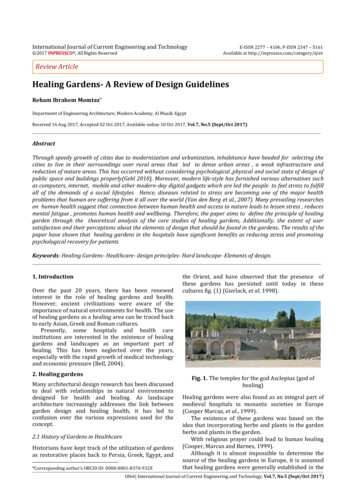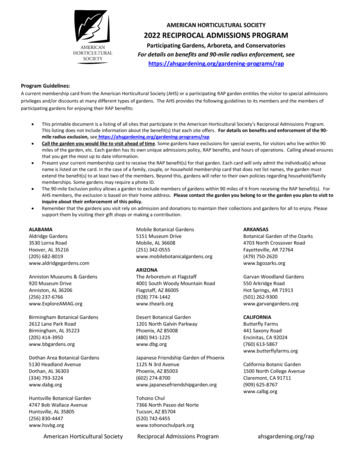
Transcription
International Journal of Education and ResearchVol. 1 No. 6 June 2013Healing Gardens’ DesignDr. Hesham El BarmelgyAssociate Professor of Urban Design and Sustainable DevelopmentDepartment of Urban DesignFaculty of Regional and Urban PlanningCairo UniversityCairo University - Main CampusGiza, Egyptbarmelgy@staff.cu.edu.eg 20-10010712311
ISSN: 2201-6333 (Print) ISSN: 2201-6740 (Online)www.ijern.comHealing Gardens’ Design(Offering a practical framework for designing of private healing gardens)Hesham M. El-BarmelgyAssociate Professor – Department of Urban DesignFaculty of Regional and Urban PlanningCairo UniversityAbstractThe paper addresses a research gap dealing with landscape and health. Stress isalways a burden on our shoulders whether at work, on the street, or even at the house.In a search to find a deep form of sustainable landscape that would act as a stressreliever, the notion of healing gardens came into light. The paper offers a practicalcase study for designing and formulating Healing Gardens (HG). It utilises the notionof design patterns in composing a framework that would empower the achievement ofthe therapeutic goals of the garden, thus providing the ability to label the garden as ahealing garden. The framework is to be presented, applied, tested and reported uponby the author, who has experienced the challenge of creating Healing Gardens.Keywords:Health, Sustainable Landscape, Healing Gardens, Healing Garden’s Design1. Introduction(Health, Landscape, Sustainability and the notion of Healing Gardens)‘Health’ and ‘well being’ have always been indicators for the ‘quality of life’,while ‘quality of life’ could be perceived as a method of measuring the degree of‘community sustainability’ (Johnson, 1995; and Dave, 2011). World HealthOrganisation defines health as “a state of complete physical, mental and social wellbeing and not merely the absence of disease or infirmity” (Vapaa, 2002:4). Vapaa(2002) added that “it [health] is this basic need for a connection with nature that keepsus going” (Vapaa, 2002:18). Investigating and proving the connection between nature,healing and health a number of studies have been conducted (Kellert et al., 2008).Three of which are mentioned below: Gull Bladder Surgery patients were studied in their recovery rooms. Somerooms had a view of nature while others had a view of a brick wall. It wasfound that patients whose rooms overlooked trees and greenery have had afaster recovery time, faster hospital departure, experienced fewer difficulties,suffered less pain and used less medication than those patients facing a wall. Michigan State Prison conducted a similar study between prisoners in cellsfacing a courtyard and prisoners in cells overlooking farmlands. It was foundthat 24% more sick calls existed among those facing the courtyard. A school in Germany conducted another similar study, students were observedin classrooms that contained plants and others in classrooms with no plants. Itwas found that plants reduced student health problems, and helped reduce thenumber of health complaints. This provided evidence that plants have apositive effect on the students’ well being.(Vapaa, 2002:22-26)2
International Journal of Education and ResearchVol. 1 No. 6 June 2013Health studies and horticultural therapeutic programs prove that there is a relationshipbetween health and gardens (Wells, 1996; Kellert et al., 2008; and Haller et al., 2006).Gardens are not only looked at as sources of physical healing but, as mental andemotional healing sources as well (Wells, 1996). The subject of health is alwaysimportant as health is something we all strive for and hope to achieve (Kellert et al.,2008). It is a positive state of life encompassing the entire life situation, andenvironment (Morse et al., 2011). The notion of Healing gardens should not just berestricted as a requirement for sick people, it is important for the healthy people asmuch as it is important for those who are sick. The paper aims to study the varioustypes of healing gardens, targeting the most efficient form of healing gardensidentified by researchers as Private Homes Healing Gardens. Moreover, the paper alsopresents a practical framework for the design and implementation of healing gardensthrough a case study. The framework was adopted and implemented by a HealingGarden Design Project Team which reports, through this paper, on the practicalexperience in the field of designing, planning and creating private healing gardens.2. The Notion of Healing Gardens (HG)2.1. Sustainability and the notion of Healing GardensGreenery, as a sustainable form of landscape, has the potential of inducingactive living and public health; thus linking the importance of the natural environmentto the built environment and the citizen’s health. In the Western and Easterncommunities it has been noticed that greenery in the city is essential for the health ofthe city dwellers. The brain is capable of two types of attention; directed attentionbelonging to the higher cognitive centres, and soft fascination linked to the memorialpart of the brain. In a natural environment, the higher cognitive centres rest while theold part of the brain is stimulated giving the sense of restoration, rest and healing.It is vital for public green areas to be located near residential areas. Studieshave proved that natural environments outside a 50 meters radius from residentialareas would result in a decrease in the amount of visits to the gardens, and an increasein stress levels. These findings reveal the significance of locating a naturalenvironment directly adjacent to dwellings (Stigsdotter, 2005). While designing ahealing garden it has been noted that ‘sight’ is the most immediate physical sense thatreacts to a garden. Sight is important because a person only needs to open his/her eyesto experience an ever-changing kaleidoscope of light and colour. Researches andstudies have proven the effect of colour on human thoughts, actions, health and evenrelationships with others (Vapaa, 2000:64). The human scene of ‘smell’ is also veryimportant in designing a healing garden. Scientists have discovered that sweetessences produce alpha, theta, and delta brainwave patterns which leads to a state oftotal relaxation. Other fragrances could stimulate beta brainwaves inducing a state ofalertness in the human brain. If the produced fragrances of a garden is disliked itwould block any effect upon the nervous system empowering the sense of alertness. Itwould thus limit the chances of a garden to promote its healing powers. Thisemphasises the importance of providing the garden with the proper scents.If healing gardens are to symbolize health promoters, then they have to offer aconsidered balance between the body, the mind, and the spirit (Vapaa, 2002). AHealing Garden is to represent the ability to promote the sustainability status betweenthe three matters as presented in figure (1). Franke (1996) made it clear through hisstatement that health is the core of the sustainable landscape, stating that "the only3
ISSN: 2201-6333 (Print) ISSN: 2201-6740 (Online)path to true sustainability is one whichpromotes the importance of the healthof the local environment" (Franke,1996: 246). Thus Healing Garden canbe considered as a deep form ofsustainable landscape where bothhumans as well as the environment areto mutually benefit from promoting it.www.ijern.comFigure ( 1) The Notion of HealingGardensSpiritBody2.2 History of Healing GardensThe idea of Healing Gardens isHealingboth ancient and modern. Following theGardensMindbeginning of human settlements anderect of communities, local healingplaces were nearly always found innature (Brown et al, 2010; and MarcusSource: after Vapaa, 2002and Barnes, 1999). The earliesthospitals and infirmaries in the Westernworld were dependent on plants, herbs and a cloistered garden as essential parts of thehealing process. For a long time the importance of health and well-being has beennoticed in the presence of urban green space, green ways, parks, green areas,schoolyards, and house private gardens. All these factors are viewed as the healthcreating elements of the city (Morse et al., 2011; and Stigsdotter, 2005). The greatgardens of Egypt were built to offer an escape from the external environment offeringa healing relief. Restorative or healing gardens for the sick have been part of thelandscape of healing since medieval times (Clark, 2004). Gardens were alwaysportrayed as a paradise that offered respite from illness to the healing of the soul andthe body. By the end of the 80’s and the start of the 90’s a decline of the concept waswitnessed all around the world. The connection between healing and nature wasgradually superseded by advancing treatment technologies and methods. By the latetwentieth century the idea of nature and healing was totally lost; nature ‘landscaping’came to be merely portrayed as a green sort of decoration. Starting from the 1990’sthe idea of healing gardens, once again, gained interest and began to appear in theresearch field of sustainable landscape (Vapaa, 2002). Today the aspect of HealingGardens is gaining its popularity due to the harsh living and environmental conditionsthat people are suffering from all over the world.2.3. Defining Healing GardensA garden, in general, is portrayed as a heaven where people find a welcomingescape from the everyday stresses of the outside world. On some level all gardenshave healing effects (Rawlings, 1998). Since this research focuses upon healinggardens, a profound theoretical analysis is required to define the term. Vapaa (2002)stated a very important definition explaining functions of a healing garden, he statedthat "instead of stressing the idea that they can cure a person, the benefits are relatedmore to the alleviation of stress and the abilities of the space to soothe, to calm, torejuvenate or to restore one's mental and emotional health" (Vapaa, 2002:4). In otherwords healing gardens are not just for sick people, they serve the healthy and theailing. A healing garden is able to restore the natural balance in humans so that theydo not feel stress and other pressures. It is defined as a category that includes outdooror indoor garden spaces. Some scholars seem to think that those gardens belong to4
International Journal of Education and ResearchVol. 1 No. 6 June 2013hospitals and health care centres (Stigsdotter, 2005), while others see that they arevery personal spaces that could be successfully located in private homes. Vapaa(2002) concluded his study stating that, "a healing garden is one where the designerpays close attention to the needs and likes of the user(s) or client(s) and is able toprovide therapeutic qualities in the space that addresses them" (Vapaa, 2002:73).Stark (2004) has a vision of the healing garden as a microcosm of the larger world,where each feature of the garden is to represent a larger feature in the landscape. Heargues that through this modelling healing has to be able to "stimulate the senses,improve immune response, and promote recuperation from physical and emotionalillness . a healing garden is a keeper of a sacred place. Its users can access higherlevels of spiritual power by their simple presence in its space" (Stark, 2004:3). Starkssees the power of the healing garden in its ability to bring the human back to nature.The nostalgic power of nature, which is embedded in each person’s higher cognitivepart of the brain, can rest while the old part of the brain is stimulated, thus achievingthe healing power.Based on literature analysis, the power of healing gardens lies in its ability tobring humans back into connection with their private imaginative nature.Accordingly, healing gardens is defined as the broad collective term that encompassesvarious types of gardens that aim to promote health and well-being to the human lifeand the adjacent environment.2.4. Types of Healing GardensThe positive health effect of staying in urban green spaces has beenrecognized. If the goal of the community is to promote sustainable development, thenin the heart of the sustainability process is the ability to promote better health for allcity inhabitants. Studies proved that each dweller has the right to have free access toan urban green space within a maximum radius of 50 meters from their residence.Consequently, the types of healing gardens can be classified as follows: The first typeof healing gardens is like a sanctuary or a natural reservoir, where natural and wildlifeare preserved. This is presented by the city’s green infrastructure elements,encompassing the city’s open spaces, green ways, nature parks and greenbelts. Thesecond type is a meditation garden within the premises of a hospital or a health carecentre. Finally, the third type is a privately owned garden. The third type is agreedupon by most healing researchers to be the best type of meditation garden withhealing effect. This is based on the fact that the more time a human is in contact withnature; the more profound the healing results will be (Hopper, 2007; Vapaa, 2002;and Marcus and Barnes, 1999).A residential or a private garden is the climax of the healing garden typology.It allows the user(s) to gain the maximum benefit from the healing qualities of agarden because it is their own personal space where they express their individualidentity, needs and level of engagement (Vapaa, 2002). The research will target theprivate healing gardens for the case study, trying to investigate the ‘healing’ reality ofsuch type of gardens. It presents a framework that would guide the landscape designprocess to promote and create healing gardens.3. Healing Gardens a facilitator for the users’ horticulture and aesthetics needsA healing garden’s main role is to provide a sanctuary to allow for meditationand, to fulfil other social and emotional requirements of its user (Johnson, 1995; andLi and Mander, 2009). A talented designer’s main job is not only to fulfil the5
ISSN: 2201-6333 (Print) ISSN: 2201-6740 (Online)www.ijern.comrequirements and needs of his/her client but, to go far beyond client expectations.Healing garden designers should use their expertise, knowledge and tools to create aunique garden for the client. As previously deducted from studying the notion,history, and definition of healing gardens along with the users’ intervention; one caninfer that the designer’s ability to integrate the user in the healing garden designprocess is a key factor for the success of the design (Brown et al., 2010). There arevarious means for achieving such integration between designer and client; the mostefficient are personal interviews, written surveys and questionnaires. During the firstsession with the client, the designer should investigate some site ideas and havefeedback on them; a good designer should be a good listener. Following the firstsession, a series of meeting and interviews with the client is a crucial step fordetermining and fulfilling the clients’ social and emotional requirements. The clientshould be involved in every detail concerning the design. When working on designsfor healing premises, the scope of the design capabilities should go far beyond theutilization of the sense of sight to all the other senses. The designer should considerwhat the client would like to hear, smell, taste and touch in their garden. The designershould constantly pay attention to the client and if there is any reservation about acertain element of the design it should be re-considered. It is always easy to reevaluate and to refine a design than to implement, demolish and re-implement. Designelements and garden components should be selected thoroughly and according to theuser’s needs and opinions. This is done to maximize the healing effects on theenvironment as well as the user, thus granting the garden with a healing label.This study stresses the importance of being able to satisfy the needs and wantsof healing garden user(s) or client(s). Client satisfaction is the key issue thatdetermines the success of the design process. The user(s) have to be acknowledged aseffective members of the design team. The success of a healing garden is onlyattained if the garden has managed to relate to its owner at the most achievablepersonal level.4. Healing Gardens Design Process/frameworkThe design process is essential for the health concept to be correctly integratedin the garden (Ji, 2009). The design should be based on the users’ special needs andrequirements. Stigsdotter, (2005) noticing the importance of the design process inachieving the required healing gardens stated that, "there is a great need for scientificknowledge concerning how these gardens should be designed" (Stigsdotter, 2005:8).McDowell and Tricia Clark-McDowell (1998) stated that, ''the key to a healinggarden is to honour and celebrate our broader human relationship with nature andspirit, not just plants." As clarified from various resources a basic set of guidelineswould be very important for directing any designer through the design process (Ji,2009). The design process of healing gardens differs than that of any normal garden inthat it has two layers of objectives. In the cognitive layer, lie the therapeuticobjectives such as the ability to provide stress relief, alleviation of physical symptomsand improvement in the human overall sense of welfare. The physical layer includesthe designers’ objectives/principles for fulfilling the therapeutic objective of thecognitive layer. Based on the former analysis and previous academic and professionalexperience, figure (2) presents a proposed vision/framework for the healing gardendesign process.6
International Journal of Education and ResearchVol. 1 No. 6 June 20134.1 HG Design Framework4.1.2. Developing Ideas.Based on the former stage thedesigner should start setting thefirst layer of ideas and thoughtsregarding how to fulfil theuser/client needs. The designershould keep their own visioninto consideration, the one thathas to be beyond the expectationof the user/client.1234Inventory Stage(Site & Users/Visitors)Developing IdeasSetting TherapeuticGoalsSetting &Composing HGDesign Patterns5Formulating theDesign6Evaluation andAssessment7ImplementationStage8Healing GardensClient/Owner or User4.1.1. Inventory Stage (Site andUsers Visits)The inventory stage of the HGdesign process differs from anyother garden design stage in thatthis stage has to include theuser/client as one of the designmembers. This is to be achievedthrough a number of visits. Thevisits should aim to investigateand listen to the user/client’sown ideas. The design teamaims to identify client’s needs tobe able to profoundly analyze,categories and prioritizes them.Mediation Stage4.1.3. Setting Therapeutic GoalsOne may argue that this designReceiverDispatcherstage should come before theprevious stage of developing theideas. It is arguable as theFigure (2) Healing Gardens’ Designframework is not rigid. SomeProposed Frameworkdesigners may find it moreappropriate to consider settingthe therapeutic goals before developing the design ideas. Others may argue that thetherapeutic goals should be hidden between the designers and their design. Thetherapeutic effect on the receivers should be accounted on.4.1.4. Selecting HG Design PatternsThe design patterns aim to assist the designer in achieving his/her therapeutic goals.These patterns are already tested for their efficiency in achieving the therapeuticobjectives. Table 1, presents a list of HG design patterns. Each design pattern standsfor the elements of the language of design, they are the individual words or phrasesthat when joined form the final story. Again this list is not compulsory and not aclosed list; on the contrary, it has to be a continuous updatable list based on designers’experiences’ and the special design conditions of each case (environmental, social,and economic).7
ISSN: 2201-6333 (Print) ISSN: 2201-6740 (Online)www.ijern.comTable (1) HG Design Patterns Proposed Open ListPatternCodeHG 01.HG 02.HG 03.HG 04.HG 05.HG 06.HG 07.HG 08.HG 09.HG 10.HG 11.HG 12.HG 13.HG 14.HG 15.HG 16.HG 17.HG 18.HG 19.HG 30.HG31.Pattern NameGarden EntranceGarden Gates and FencesGarden Walls (natural as possible using plants and earth materials)Positive Outdoors Spaces (positive outdoors spaces functionally related to yourhome or building)Hierarchy of Open SpacesIntimacy Gradient (space hierarchy, unfolding story, introduction spaces)Anchor points at the heart (try to present interest points in the middle of thespaces)Connection with Nature (connect your garden with Mother Nature whenever itis possible, through views from spaces)Tree place (try to make them as natural as possible)Vegetable and Fruit GardenRaising FlowersSupporting wildlife (colours, materials, and plants)Shading Areas (natural as possible, pergolas or trees)Arcades and Archways (providing interesting walking paths)Paths and Goals (paths layout linking spaces together)Path ShapePaths smoothing roughly in the middle (the middle of the path should smoothroughly to include an interest anchor/space or point)Sequence of Sitting AreasConnection with the SunGarden Seats (place, function, material and views)Alcove (small sitting areas)Sitting CirclesSeats Spots (location advantages)Front Door BenchUsing Water (ponds and pools)Fountains and Water dropsWater FallsActivity Pocket (working, studying . )Settled Work in the GardenWaist High Shelf (sort of working areas)Car Homes (caring and working areas)(after, Christopher et al., 1977; Vapaa, 2002 and Tyson, 2007)4.1.5. Formulating the Design (HG Design Stage)The design formulation/creation is the heart of the design process of Healing Gardens.A healing garden needs to express and present nature and its forms. It should escapeand avoid rigidity, conceptual thinking and preconceived notions of design. Asuccessful Healing garden design should be able to achieve the following designobjectives:1. Maintain the spiritual character of the site2. Accentuate the aesthetics values of the design3. Create a variety of spaces4. Encourage exercise5. Minimise intrusion6. Encourage vegetation and wildlife7. Support the intention and care of its owners8. Prevalence of green material9. Provide positive destruction10. Minimise ambiguity(after: Stark, 2004; Vapaa, 2002; Cooper and Barnes, 1999; and Stigsdotter, 2005)8
International Journal of Education and ResearchVol. 1 No. 6 June 2013Whilst designing, designers should avoid straight lines, volumes and planes andexcessive use of symmetry. Also, among the guidelines that would help in achievingthe required HG design objectives are: Involve the user/client throughout theprocessEasiness to comprehend and navigateConsidering mobility in and aroundSupport all forms of wildlifePromote reflection and self awarenessMaximum use of water elementsSpecial consideration for the garden wallsProviding working natural environmentCreative use of colour and lightAnchor points and creative nodesThe integration of art to support Stimulating the users sensesCreative use of water elementsOffering contrast as a source of reliefViews from inside and outsideUtilise the cycle of life and seasonsSpecial entrance that would invite andembrace users into the gardenUtilising white noises wheneverpossibleEmphasis of natural features asgrounding pointsSitting areas(after: Marcus and Francis, 1998; Foley; 2010 Stark, 2004; Vapaa, 2002; Cooper andBarnes, 1999; and Stigsdotter, 2005)4.1.6. Evaluating the Design (HG Certification Process)The continuous evaluation of the process in every stage is a core for its success. Theevaluation is to be conducted merely by the client(s)/user(s) and the design team. Theevaluation should recognise two matters; the continuous evaluation of the targetedhealing objectives and the changes required to the targeted HG design patterns. Thecreativity of the design team in designing the elements of the requested design patternis a determinant of HG success.4.1.7. Implementation ProcessThe implementation process may differ than that of an ordinary garden in two mainpoints. First is the special need and consideration that has to be provided in selectingthe construction material. The material has to be completely related to earth. Thesecond point is engaging the user(s)/client(s) in the construction process. Everyconstruction detail of hardscapes and softscapes has to be done in consideration to theclient’s needs and desires.4.1.8. Mediation Process (HG users gardening)A healthy plant is a main factor in a successful HG, where the impact of these healthyplants is mediated to its user. HG is unique in its ability to engage its user in thegardening tasks, through which mediation is maintained, and the therapeutic goals areachieved. In other words, the extent to which a HG is successful in engaging itsuser(s) in the gardening work is the expected extent of achieving a high level ofhealth, therapeutic and mediation effects.5. Healing Garden Proposed Design Framework in actionThe case study of creating a Healing Garden Design is to be presented onthree stages: the first is to report on the arrangement prior to the actual engagement ofthe design process. The second stage is to report on the framework presenting the HGdesign process. The final stage concerns the mediation process of the garden with itsuser(s).5.1 HG Pre-design StageThe preparation prior to the start of the HG design process is of vital importance forthe success of the process and for achieving the required objectives. The main task ofthe HG pre-design stage is composing the design team. The design team is to act as9
ISSN: 2201-6333 (Print) ISSN: 2201-6740 (Online)www.ijern.comthe tool through which the required design is to be formulated. The composition of theright team (design team) is essential for the success of any design. There are somefactors that can guide the process of composing the required team. They include: The technical head of the team should have the required knowledge of the HGdesign process (to be identified based on the already developed fields ofexpertise in each country). Depending on the client’s gender, age, norms, ethics and religion, a number ofdesign members should be included that have the privilege of being able to getin close contact with the user(s). If the client is a family unit includinghusband and wife, then the team should include at least a female and a malemember. The aim here is to establish a personal link with the clients. The team should include a local softscape and hardscape designer. The team should include a designer with the required lightning designexperience. An assisting team, to the main HG design team, should include economic, soil,agriculture, irrigation and construction experts. The head of the team should be the client; he/she should be convinced thatthey are to play an important role in the success of the HG design process.In composing the team for the presented case study, the client was a business man.His family had four members, his wife, daughter and two sons. The assignment was todesign a private and special garden to his already constructed new house. The clientalready possessed a design prepared for him by a professional landscape firm. Hecommented that, “I am not happy with that design. I can’t see myself in it”.Accordingly, the composed main team was set to include HG designprofessional, a female internal designer (an architect, who is close in age, social,economical and ethical class to the client’s wife), a local landscape designer(softscape and hardscape), an assistant landscape designer (a male member close inage to the client’s two sons). The composed team provided the required expertise inthe identified fields and ensured the maximum integration with the client’s family. Inaddition to the main team there was an assisting team which included lightening,economic, agricultural, soil and construction experts.In presenting this case study, if the design team is referred to withoutmentioning the assisting team this addresses the main HG design team members only.Also, the paper focuses on the exclusive requirements of the HG design process, thusit skips the mutual points that are common for any ordinary garden design.5.2 HG Proposed Design Framework Process5.2.1 The Project Inventory StageThe inventory stage of the HG design process should include:1. Site VisitSite visit(s) is the first step of the HG design process. The main team has toaccomplish the objective of getting to know the client and the project site very well.During this stage the design team focuses on achieving maximum socialization withthe site and the client(s). A documentation plan of the healing garden’s specialrequirements includes documents inquiring: security issues, privacy issues, varioussources of pollution (health, sound and visual), prevailing wind, serene natural outerviews and all possible local environmental records.10
International Journal of Education and ResearchVol. 1 No. 6 June 20132. Defining the User(s) NeedsFor any design to succeed it needs to meet the needs of its users. Thus the ability todefine the user’s needs is an essential task for the success of any design. For HGsdefining needs is not only essential, but is the core, and the fundamental, stem fromwhere the design of the HG should branch. Based on the first inventory socializingstage included in the ‘site visit’, the design team was able to formulate a prime list foreach member of the client’s family. These prime lists were finalised upon on anumber of meetings that were conducted with each member of the client’s family.These meetings consisted of one member from the client’s family and members of thedesign team. This allowed for a relaxed conversation where the design team was ableto understand the needs of each member. According to the results of
reliever, the notion of healing gardens came into light. The paper offers a practical case study for designing and formulating Healing Gardens (HG). It utilises the notion of design patterns in composing a framework that would empower the achievement of the therapeutic goals of the garden, thus providing the ability to label the garden as a










